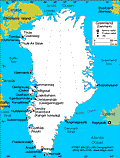The Inuit are believed to have crossed from North America to northwest Greenland, the world's largest island, between 4000 B.C. and A.D. 1000. Greenland was colonized in 985–986 by Eric the Red. The Norse settlements declined in the 14th century, however, mainly as a result of a cooling in Greenland's climate, and in the 15th century they became extinct. In 1721, Greenland was recolonized by the Royal Greenland Trading Company of Denmark.
Greenland was under U.S. protection during World War II, but it maintained Danish sovereignty. A definitive agreement for the joint defense of Greenland within the framework of NATO was signed in 1951. A large U.S. air base at Thule in the far north was completed in 1953. Under 1953 amendments to the Danish constitution, Greenland became part of Denmark, with two representatives in the Danish Folketing. On May 1, 1979, Greenland gained home rule, with its own local parliament (Landsting).
In November 2008, Greenland's voters approved a set of changes to give themselves more autonomy from Denmark, a step that could lead towards full independence. A ceremony in June 2009 marked the beginning of self-governance over areas like criminal justice and oil exploration. The official language of Greenland became Kalaallisut, a traditional Inuit dialect.
The left-wing opposition party, Inuit Ataqatigiit, won parliamentary elections with 44% of the vote, defeating the Siumut party, who had governed for over 30 years.
On April 5, 2013, Aleqa Hammond became Greenland's first female prime minister. After the 2013 elections, her party, Siumut, emerged as the largest. Over a year later, on Oct. 1, 2014, Hammond took a leave of absence due to an expense scandal. While under investigation, Hammond was replaced by Kim Kielsen.


